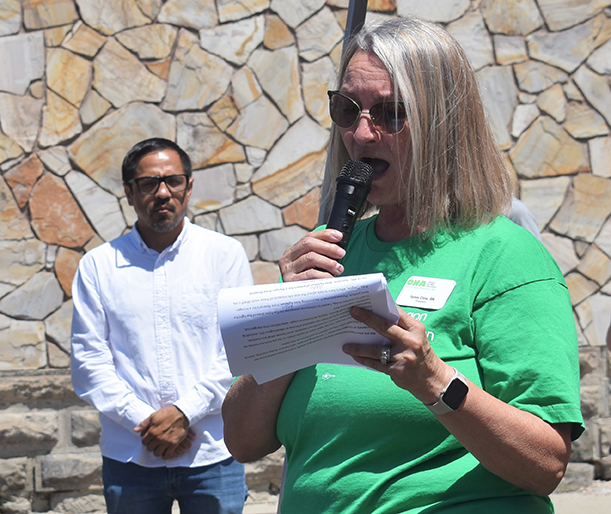SEAT on the Table
Published 1:41 pm Thursday, March 24, 2016

- A single-engine air tanker drops a load of retardant at the Prineville Airport during a demonstration in 2015.
Trying To Have A Firefighting Air Tanker Stationed At The Baker City Airport
Mark Bennett hopes the focus on protecting sage grouse can add muscle to Baker County’s firefighting abilities.
Aerial muscle, to be specific.
Bennett, a Baker County commissioner, said the campaign at both the Oregon and national levels to preserve the bird includes millions of dollars for a variety of projects.
His idea is to see whether Baker City and Baker County could use some of that money for upgrades at the Baker City Airport – work that would make it possible to park a firefighting single-engine air tanker there.
Bennett emphasized that his proposal is preliminary. He hasn’t confirmed that improvements at the airport would qualify for sage grouse money.
“But it would be nice to be ready if the opportunity comes along,” he said Tuesday.
The topic is on the agenda for a meeting of city and county officials today at 5:30 p.m. at the Courthouse, 1995 Third St.
Although the U.S. Forest Service and the BLM stationed a single-engine air tanker (SEAT) at the airport on a temporary basis, say two to three weeks, during summers several years ago, the airport’s well lacks the capacity to supply a tanker, which can carry 600 to 800 gallons of fire retardant, on a long-term basis, Bennett said.
Baker City Manager Mike Kee said a state law prohibits the city from extending water lines to the airport because the property is outside the city’s urban growth boundary.
That means a well is the only potential source for additional water.
Kee said he’s intrigued by Bennett’s idea.
Besides augmenting firefighting, bolstering the airport’s water supply could have ancillary benefits for the city, Kee said, making the property more attractive to industrial and other developments.
“We’ve really missed some opportunities out there because of the inability to serve the airport better with water and sewer,” Kee said.
Troy Woydziak, who owns Baker Aircraft Inc., which handles fuel sales, aircraft rentals and other activities at the airport, said he would welcome having a SEAT or other firefighting aircraft based at the airport.
Airports that are permanent tanker bases, including La Grande/Union County, Ontario and John Day, can realize “huge increases” in fuel sales during the fire season, Woydziak said.
He said Bennett’s idea of seeking money from federal sage grouse-protection budgets is plausible.
Woydziak, who assists in firefighting, said that last summer, while he was in Grant County, he talked with a helicopter pilot who had a federal contract to fight fires that threatened sage grouse habitat in Southeastern Oregon and Northern Nevada.
Woydziak said the pilot had been temporarily assigned to the Grant County fire that destroyed more than two dozen homes near John Day.
SEATs of power
SEATs have become an increasingly valuable firefighting weapon over the past 15 years or so, said Noel Livingston, deputy fire staff for operations on the Wallowa-Whitman National Forest.
The aircraft, due to their relatively small size, can dump retardant on fires that are not accessible to larger, multi-engine air tankers, Livingston said.
“They’re much more agile,” he said. “They’re a great tool for initial attack.”
The BLM frequently employs SEATs to work on range fires because the aircraft’s retardant loads, though less than what big tankers can haul, often is sufficient to stop blazes in lighter fuels such as grass and sagebrush, Livingston said.
He said Forest Service fire managers often dispatch SEATs to fires in Hells Canyon, where the topography is better suited to smaller planes.
“That’s tough country to fly in,” Livingston said.
If the Baker City Airport could accommodate a SEAT on a long-term basis, there’s still the matter of convincing officials from a federal agency such as the Forest Service or BLM, or the Oregon Department of Forestry, to assign an aircraft to the airport, Livingston said.
One reason the Forest Service and BLM haven’t stationed a SEAT in Baker City, even temporarily, the past few summers is that the state Forestry Department now maintains a pair of SEATs at the La Grande/Union County Airport, he said.
That airport is a major air tanker base, with facilities, including retardant tanks, to support not only SEATs but also multi-engine tankers, Livingston said.
Bennett said last summer’s record-setting wildfire season in Baker County heightened his concern about the ability of local agencies to attack blazes as quickly, and effectively, as possible.
See more in Wednesday’s issue of the Baker City Herald.









